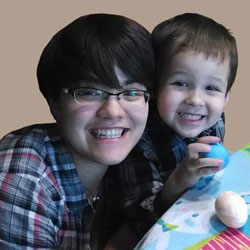
Credit: Karen Carlson
Fields: Systems biology, bacterial biofilms
Born and raised in: Alaska
Undergraduate student at: The University of Alaska, Anchorage
When not in the lab, she’s: Out and about with her 3-year-old son, friends and family
Secret talent: “I make some really good cookies.”
Karen Carlson got a surprise in her 10th grade biology class. Not only did she find out that she enjoyed science (thanks to an inspiring teacher), but, as she puts it, “I realized that I was really good at it.”
In particular, she says, “I was good at putting all the pieces [of a scientific question] together. And that’s what I had the most fun with—looking at systems: how things fit together and the flow between them.”
These are perfect interests for a budding systems biologist, which is what Carlson is on her way to becoming. She’s a senior in college on track to graduate this year with a bachelor’s degree in biology from the University of Alaska, Anchorage (UAA). Next, she plans to enroll in a master’s degree program at UAA, and eventually to pursue a Ph.D. in a biomedical field.
Carlson already has substantial research experience under her belt. For two summers, she participated in the Alaska Oregon Research Training Alliance (AORTA). This program provides the opportunity for undergraduates from Alaska—many of whom are Native Americans or Alaska Natives— to work at the University of Oregon, where they participate in summer research at the Microbial Ecology and Theory of Animals (META) Center for Systems Biology. The META Center aims to understand the inner workings of host-microbe systems (for example, the bacterial communities that live in our guts) and use this knowledge to advance human health.
During her first summer in Oregon, Carlson learned the techniques needed in a modern microbiology lab. With a mentor, she began studying Bacillus subtilis, a bacterium that is typically harmless—and is even used as a food additive. She examined how the bacterium changes its physical characteristics when it clusters to form a biofilm (a sticky community of microbes that can live in the body, on hospitable surfaces or virtually any other area—including the kitchen sink—containing moisture and nutrients).
“What I really like about the AORTA program is that they let us choose our own projects,” says Carlson. “When I talk to a lot of other [undergraduate] students doing research, they were just following what the grad students were doing. But with AORTA, they asked ‘what would you like to do?’ We told them our interests, and they guided us. They really made me feel that my project was my own.”
She returned to the META Center the following summer to get more hands-on experience with growing and studying bacterial biofilms. That summer, she focused on Vibrio bacteria. Some species of Vibrio are harmless, while others can cause food poisoning, serious skin infections or even cholera, a potentially fatal diarrheal disease.
Both times in Oregon she was accompanied by her young son Gabriel and her mother, who helped with childcare while Carlson was in the lab. As a single mother, Carlson has to continually balance raising a young child with the demands of her own scientific education. When she was accepted into the AORTA program, she asked whether her family could come and share her on-campus housing. The META Center said yes.
“Don’t be afraid to ask for help,” is the advice Carlson would give to any student trying to balance family obligations with their education. “My family and friends have been a great support system; I couldn’t have done it without them.”

